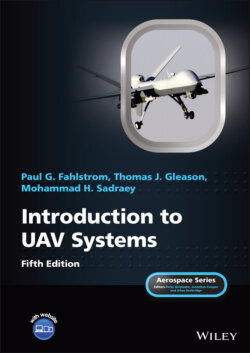Читать книгу Introduction to UAV Systems - Mohammad H. Sadraey - Страница 46
1.6.2 Reaper
ОглавлениеAfter about 10 years of Predator operations, and when some weaknesses were identified, new challenges arose in employing Predator. DOD decided to have a new version of Predator with enhanced performance features and an advanced design. The operation requirements included such performance items as a faster cruising speed and higher flight altitude, and also heavier and more advanced payloads. The conceptual design and the air vehicle configuration were almost kept. The only major configuration change was to have a V‐tail instead of an inverted V‐tail.
The US Air Force first deployed the MQ‐9 Reaper (developed by General Atomics, then called Predator B) to Afghanistan in October 2007 for precision airstrikes and it slowly began replacing the Predator. The General Atomics MQ‐9 Reaper (Figure 1.5) flew its first operational mission in Iraq in July 2008. In the meantime, the Army began development of a refined derivative, the MQ‐1C Gray Eagle, which began operations in 2012. The US Air Force retired the Predator in 2018, replacing it with the Reaper.
Figure 1.5 General Atomics MQ‐9 Reaper
Left: A British MQ‐9A Reaper operating over Afghanistan in 2009
(Source: Tam McDonald / Wikimedia Commons / OGL v1.0).
Right: CBP’s Reaper
(Source: Gerald L. Nino / Wikimedia Commons / Public Domain)
The first version of Predator (A) had a piston engine, but the upgraded Predator B, or MQ‐9 Reaper, is equipped with a turboprop engine (with a greater power). Predator B is larger, much heavier, with an improved flight performance (e.g., faster cruise speed, longer range, and longer endurance) than the earlier MQ‐1 Predator.
There are two groups of Payloads: (1) surveillance imagery sensors, which include a synthetic aperture radar, electro‐optic video, and forward‐looking infrared (FLIR) cameras, (2) weapon payloads, which include four anti‐armor missiles AGM‐114 Hellfire), two laser‐guided bombs (GBU‐12), and 500 lb joint direct attack munition. Other payload options include a laser designator and rangefinder, electronic support and countermeasures, a moving target indicator (MTI), and an airborne signals intelligence payload.
